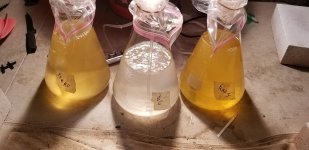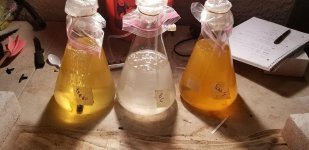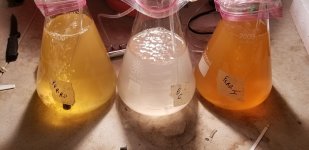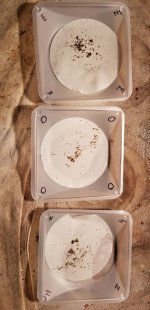SaltwaterServr
Sr. Member
Most folks know that when it comes to free-mill gold, you'll get between 35% and 60% of the gravity recoverable fraction with the remainder only available via chemical leaching. Even with mercury, you won't grab the remainder. The options for gold leaching at a commercial level have historically been HCl leaching with a few other alternatives until cyanide came onto the playing field in the late 1800's.
Due to it's toxicity in water it's almost impossible for small scale miners to be able to purchase NaCN or KCN for processing. We're then left with few alternatives that are commercially available.
Eco-Goldex is one commercially available product that is based on potassium ferricyanide. I compared it with a leach of pure potassium ferricyanide and potassium ferrocyanide.
All solutions have 0.2% of their respective compounds, 1.506 grams of gold with no more than .5 grams of picker sized gold per flask. pH is a little high to start, 12.01, but in my experience that would settle down a bit to the mid 11 range. Testing for the rate of cyanogen activity as well as loading capacity of each solution. In layman's terms I was looking for which solution dissolves the gold the fastest and which one will hold the most gold after 72 hours. (turned into 96 hours) You'll be able to tell which one has the most gold in solution by the amount of gold not dissolved in each flash at the end of the experiment period.
Also tracking reagent consumption of the NaOH for each solution, although on the scale most of us will be doing this, that cost is minimal.
End of day 1:

End of day 2:

End of Day 3:

and the resulting remaining gold from each at the end of day 4. O is ferrocyanide, I is ferri, E is eco-goldex. Note the iron left behind in the Goldex. BTW, all gold is from the same spot on one hill in Arizona.

Results of the trial
Remaining gold from the starting point of 1.506 grams per flask:
Ferrocyanide: 1.440 grams
Eco-goldex: 1.389 grams
Ferricyanide: 1.371 grams
Ferrocyanide ate the most sodium hydroxide by far, which is expected as it forms hydroferrocyanic acid in solution.
Now the economics. Ferro and ferri were both reagent grade chemicals, but it's hard to get your hands on lower grade stuff.
Ferro is $42.20 per kilogram with free shipping from amazon through Prime.
https://www.amazon.com/gp/product/B00DYO7VT2/ref=oh_aui_detailpage_o04_s00?ie=UTF8&psc=1
Ferricyanide is much more expensive. I paid $39.84 with shipping (not prime eligible) for only 500 grams. Equivalent price is then about $79, depending on shipping. If you go buy it at the manufacturer's website you can get it for $57.08 per kilo with a 2.5 kg purchase and standard shipping.
https://www.amazon.com/gp/product/B01N1WLBDB/ref=oh_aui_detailpage_o00_s00?ie=UTF8&psc=1
and straight from the source:
https://www.sciencecompany.com/NSearch.aspx?keywords=potassium+ferricyanide
Eco-Goldex blows them both away. I bought 25kg of the stuff, and with shipping it came out to $11.00 per kg. Shipping was $50.00 including customs and all that from Canada.
Eco-Goldex's active ingredient is ferricyanide, but they've already processed it and powdered it. The difference is it is coming from China. It's damn hard to beat the economics of it.
Next step, going to pick up some gold foil and run some more tests on Eco-goldex with four different retention times 24 hours, 48, 72 and 96. It'll be sometime next week before I start that.
Due to it's toxicity in water it's almost impossible for small scale miners to be able to purchase NaCN or KCN for processing. We're then left with few alternatives that are commercially available.
Eco-Goldex is one commercially available product that is based on potassium ferricyanide. I compared it with a leach of pure potassium ferricyanide and potassium ferrocyanide.
All solutions have 0.2% of their respective compounds, 1.506 grams of gold with no more than .5 grams of picker sized gold per flask. pH is a little high to start, 12.01, but in my experience that would settle down a bit to the mid 11 range. Testing for the rate of cyanogen activity as well as loading capacity of each solution. In layman's terms I was looking for which solution dissolves the gold the fastest and which one will hold the most gold after 72 hours. (turned into 96 hours) You'll be able to tell which one has the most gold in solution by the amount of gold not dissolved in each flash at the end of the experiment period.
Also tracking reagent consumption of the NaOH for each solution, although on the scale most of us will be doing this, that cost is minimal.
End of day 1:

End of day 2:

End of Day 3:

and the resulting remaining gold from each at the end of day 4. O is ferrocyanide, I is ferri, E is eco-goldex. Note the iron left behind in the Goldex. BTW, all gold is from the same spot on one hill in Arizona.

Results of the trial
Remaining gold from the starting point of 1.506 grams per flask:
Ferrocyanide: 1.440 grams
Eco-goldex: 1.389 grams
Ferricyanide: 1.371 grams
Ferrocyanide ate the most sodium hydroxide by far, which is expected as it forms hydroferrocyanic acid in solution.
Now the economics. Ferro and ferri were both reagent grade chemicals, but it's hard to get your hands on lower grade stuff.
Ferro is $42.20 per kilogram with free shipping from amazon through Prime.
https://www.amazon.com/gp/product/B00DYO7VT2/ref=oh_aui_detailpage_o04_s00?ie=UTF8&psc=1
Ferricyanide is much more expensive. I paid $39.84 with shipping (not prime eligible) for only 500 grams. Equivalent price is then about $79, depending on shipping. If you go buy it at the manufacturer's website you can get it for $57.08 per kilo with a 2.5 kg purchase and standard shipping.
https://www.amazon.com/gp/product/B01N1WLBDB/ref=oh_aui_detailpage_o00_s00?ie=UTF8&psc=1
and straight from the source:
https://www.sciencecompany.com/NSearch.aspx?keywords=potassium+ferricyanide
Eco-Goldex blows them both away. I bought 25kg of the stuff, and with shipping it came out to $11.00 per kg. Shipping was $50.00 including customs and all that from Canada.
Eco-Goldex's active ingredient is ferricyanide, but they've already processed it and powdered it. The difference is it is coming from China. It's damn hard to beat the economics of it.
Next step, going to pick up some gold foil and run some more tests on Eco-goldex with four different retention times 24 hours, 48, 72 and 96. It'll be sometime next week before I start that.
Last edited:



 Is what your doing the same idea as Aqua Regia? Could I throw gold and other metals in a solution of this and it would work the same way? Dropping(?) the metals out one by one. Or is this specific to what your doing with rock....
Is what your doing the same idea as Aqua Regia? Could I throw gold and other metals in a solution of this and it would work the same way? Dropping(?) the metals out one by one. Or is this specific to what your doing with rock....


